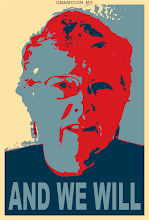University Reverses Policy to Allow Mascot's Return
CHICAGO, Oct. 27 — Chief Illiniwek has not yet left the campus.
Students for Chief Illiniwek marched in the University of Illinois homecoming parade on Friday.
Months after the University of Illinois decided to retire the mascot officially, banning him from university activities, the image of Chief Illiniwek, a buckskin-clad American Indian, was allowed to return to an event during homecoming celebrations this weekend on the Urbana-Champaign campus.
His likeness appeared on the side of a couple of floats, face-forward, fully framed in feathers.
In the name of free speech and in a reversal of policy, Chancellor Richard Herman lifted a prohibition on the use of the Chief Illiniwek logo on homecoming parade floats just a day before the parade rolled on Friday night.
“The university values free speech and free expression,” the university said in a statement, “and considers homecoming floats, decorations, costumes and related signage all representations of such personal expression. Therefore, Chancellor Herman has directed the Homecoming Committee to strike the existing policy from the homecoming float guidelines.”
A few thousand spectators showed up on campus for the parade, and about half of them were sporting some sort of Chief Illiniwek paraphernalia somewhere on their bodies. There were no protesters.
As an official mascot, Chief Illiniwek performed for the last time in February. He was retired under pressure from the National Collegiate Athletic Association and amid heated debate at the university, though the university’s sports teams retained the nickname Illini. A symbol of university and geographic pride to many, Chief Illiniwek came across to others as a racial stereotype from another time.
He was 81 years old.
The chief’s main function was to dance for a few minutes at halftime during basketball and football games, but he had a devoted following, to say the least, and even his own society, called Honor the Chief. The society’s Web site says it was founded to help the public “recognize the difference between an athletic mascot and a time-honored symbol of tradition and respect.”
But, in one sense, he was a relic. The push to erase American Indian nicknames from college campuses began in the 1960’s in Indian communities and at universities. At the time, there were thousands of athletic programs with such nicknames.
But by 2000, the use of Indian mascots and names had disappeared from all but a handful of major universities. In 1991, the University of Illinois’s own student government association found Chief Illiniwek to be discriminatory and called for the mascot’s elimination. In 2005, the N.C.A.A. announced a policy that prohibited athletic programs using so-called abusive imagery from being the hosts for postseason games and banned the use of Indian nicknames. The policy also banned the use of such images by coaches, players, cheerleaders, band members and others.
But even after Chief Illiniwek was banished, he never really went away.
“It’s still everywhere, on clothing and merchandise, people have it and it’s still around,” said Yael Dvorin, a senior from Des Plaines, Ill. “It’s not taken away. After years of having that material, chief paraphernalia is everywhere. It is still very visible in that sense.”
Charlene Teters, the vice president of the National Coalition on Racism in Sports and Media and a member of the Spokane Nation, began the movement to eliminate Chief Illiniwek at Illinois in the late 1980s. Ms. Teters did not return calls for comment, but on her Web site, she noted that “the effort to remove Chief Illiniwek was never about the mascot, it was and remains to be about racism.”
The N.C.A.A.’s executive committee rejected an appeal last year by the University of Illinois to continue using its Chief Illiniwek athletic mascot. On Friday, a spokeswoman said that N.C.A.A. policy only covered athletic events, so the use of the chief’s image at a parade was an internal university issue.
But the spokeswoman, Dana Thomas, said the University of Illinois would be invited to participate in N.C.A.A. championships only if it did so without American Indian references on its uniforms and associated athletic program activities.
Still, the decision to allow the chief’s image on floats left some students questioning the administration.
“Free speech — in this context I’m not sure I agree because the homecoming parade is through the university,” said Scott Schwartz, a senior molecular and cellular biology major. “A lot of bending of rules.”
The chief is still such a hot point of contention that the university’s student newspaper, The Daily Illini, would not discuss the homecoming issue and does not plan to publish an editorial position on the rule reversal.
Students who were interviewed mostly said they could see both sides of the issue, but remain faithful to the chief.
“To me it is a very honorable and loyal symbol,” said Haley Beenenga, a senior from Bloomington, Ill. “I love the chief and I wish it was still here, but I also understand how it can be offensive. Now I want to know, is he around or not around? What’s the decision? Clearly it’s hard to get rid of something that’s been around so long.”
Robin Kaler, the university’s associate chancellor for public affairs, said the nature of the event, a public parade, overrode concerns about the university’s sponsorship.
“We wouldn’t ban a member of the campus community from wearing chief paraphernalia to class or work,” she said. “We’re not going to ban them from doing that in the parade either.”


Links to this post:
Create a Link
<< Home